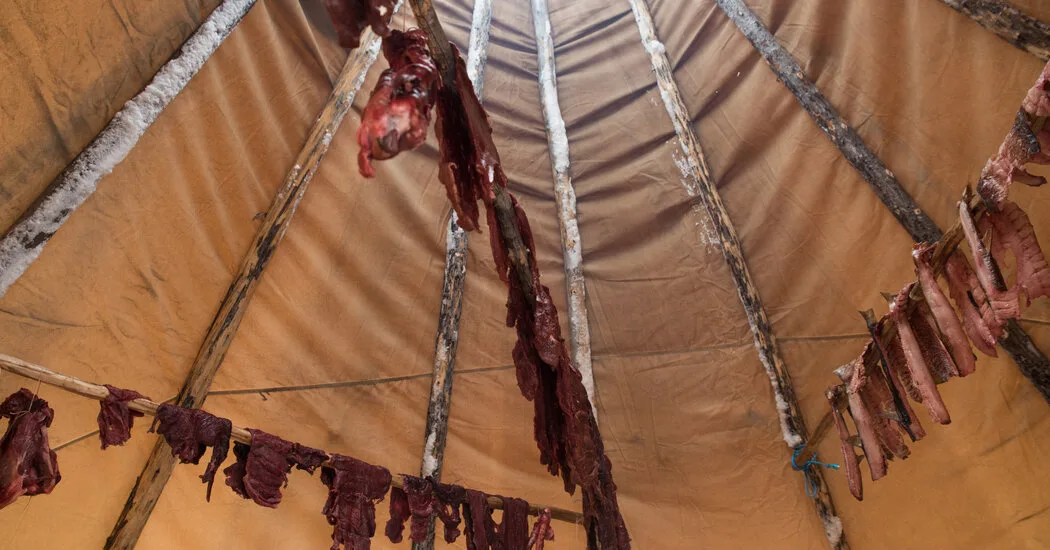
In “Endangered Eating,” the food historian Sarah Lohman explores the onetime staples disappearing from our tables.
ENDANGERED EATING: America’s Vanishing Foods, by Sarah Lohman
In Nashville, there’s a precisely conceived country restaurant called Audrey, which the chef Sean Brock named after his Appalachian grandmother. His menu is an exercise in the theory that in order to save food on the brink of extinction, you must eat it.
Recently, he served a $48 pork dish from the exceptionally fatty hogs living on Ossabaw Island, which is off the coast of Georgia near Savannah. They are the direct genetic descendants of pigs the Spanish conquistadors dropped there in the 1500s.
He paired it with Carolina Gold rice, a grain that funded the South’s colonial and antebellum economies. After the Civil War, it fell out of favor. Other rice was cheaper and easier to grow and didn’t require the labor of the enslaved. It was essentially moribund until the 1980s, when a South Carolina eye surgeon and hunter started growing it on his 400-acre plantation.
The pork and rice are among some 300 foods in danger of disappearing as determined by Slow Food USA, an organization that champions local food and traditional cooking. Their Noah-esque catalog is called the Ark of Taste.
Sarah Lohman, an intrepid gastronomic historian, dived into eight Ark entries as the basis for “Endangered Eating: America’s Vanishing Foods.” It’s as much a fascinating study of heirloom cider apples and Buckeye chickens as it is a commentary on the way politics, money and convenience have conspired against America’s culinary history.
This isn’t a book to pick up for its lyrical narrative. (One can wade through only so many descriptions of rental car trips and bad weather.) Still, the deep cultural and political history Lohman unearths is worth the ride.
She’s no stuffy academic. Lohman is more like your smart, affable friend who forgets to take enough warm clothes for a canoe trip to harvest native wild rice or shows up to help net salmon in tennis shoes and yoga capri pants.
She picks up a knife at a gathering of Diné tribe members on the Navajo reservation to help butcher and cook every bit of a 150-pound Navajo-Churro ram. The sheep are part of the Navajo creation story, their wool woven into blankets and their meat long sustaining the Diné, the largest Indigenous tribe in the United States.
As she helps clean the sheep’s four stomachs, she’s offered a slice. Raw stomach is considered powerful medicine.
“I thought to myself, ‘Are you really going to eat that raw stomach?’ On these trips, when someone asks if I want to do/try/experience something/go somewhere, my policy is always to say yes,” she writes. “I popped a slice of raw stomach in my mouth. It was surprisingly crunchy and tasted like a barnyard.’”
She offers some recipes, although it is the rare reader who will have the ambition to tackle blood sausage made in the Diné tradition. Whole pink salmon baked with Dijon mustard, a recipe she picked up from the leading practitioner of an ancient Straights Salish tribal technique called reef net fishing, looks more manageable.
Some journeys were less challenging, like a walk through the Coachella Valley’s date gardens to taste rare, chewy treats with names like the Empress and Blonde Beauties or a trip to Hawaii to suck on sticks of legacy sugar cane, where five varieties of kupuna kō are being revived. She eats gumbo in Louisiana’s Cajun country, learning the nuances of grinding sassafras leaves to make the Choctaw filé that thickens her soup.
Delicious adventures aside, the book is also a somber story of disenfranchised people, especially Native tribes whose food traditions suffered under colonization and westward expansion. Development, agricultural runoff and lakes dammed for recreation have pummeled the northern ecosystems where the Anishinaabeg, the Menomini and the Sioux use traditional methods to harvest the wild rice called manoomin.
The federal government pushed the Diné onto smaller and smaller sections of land that couldn’t support their herds, and forced disastrous crossbreeding of their spirited, longhaired Navajo-Churros.
And then there is the story of the small, sweet Carolina African runner peanut, once a big commercial crop in the South. Enslaved people from West Africa brought the peanuts to Charleston in the late 17th century. They fed Black families and later provided a little money, which could aid in buying freedom.
Farmers stopped planting them in favor of legumes that were larger and easier to process. By the 1950s they were functionally extinct. In 2006, the Southern food scholar David Shields (who recently published his own book on the Ark of Taste) found the last 40 African runner peanuts in a North Carolina State University cold storage facility.
Since then, the rare peanuts have shown up on Sean Brock’s menu, eaten by diners for whom a $300 dinner bill is paid without a thought. But, writes Lohman, they are not “getting back in the hands of Black farmers and chefs.” And, Black food historians point out, they weren’t saved to help Black culinary culture survive. “The focus,” Lohman writes, “seemed to be on saving functionally extinct foods at all costs, particularly targeting high-end chefs and wealthy diners to ensure an ingredients survival.”
It’s a quandary. Without companies like Patagonia that sell the Salish-harvested salmon or chefs like Brock who make food with rare pork and peanuts, the Ark of Taste itself might sink.
But, she wonders, is the cost of eating it to save it too high? A growing interest in a type of rum made from legacy Hawaiian sugar cane helps fund its preservation, but Native Hawaiians suffered greatly when English explorers introduced alcohol to the islands when they landed in 1778.
“I discovered the path to saving ingredients wasn’t clear-cut,” Lohman writes. “Nor was the question of who should have access to these ingredients — and at what price.”
ENDANGERED EATING: America’s Vanishing Foods | By Sarah Lohman | Norton | 307 pp. | $28.95

